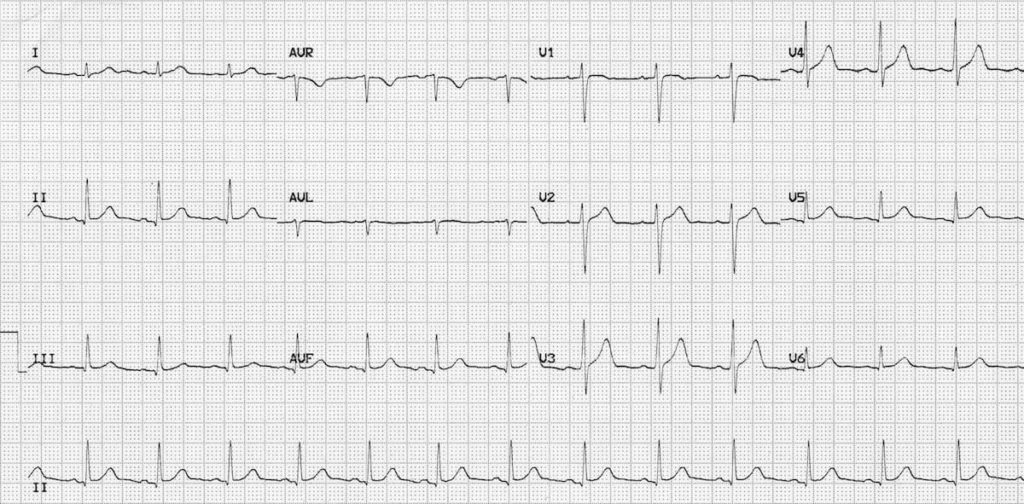Normal Sinus Rhythm
Overview of normal sinus rhythm (NSR)
- The default heart rhythm
- Pacemaking impulses arise from the sino-atrial node and are transmitted to the ventricles via the AV-node and His-Purkinje system
- This results in a regular, narrow-complex heart rhythm at 60-100 bpm

ECG features of normal sinus rhythm
- Regular rhythm at a rate of 60-100 bpm (or age-appropriate rate in children)
- Each QRS complex is preceded by a normal P wave
- Normal P wave axis: P waves upright in leads I and II, inverted in aVR
- The PR interval remains constant
- QRS complexes < 100 ms wide (unless co-existent interventricular conduction delay present)
Normal heart rates in children
- Newborn: 110 – 150 bpm
- 2 years: 85 – 125 bpm
- 4 years: 75 – 115 bpm
- 6 years+: 60 – 100 bpm
Variations on sinus rhythm
- Sinus tachycardia = sinus rhythm with resting heart rate > 100 bpm in adults, or above the normal range for age in children
- Sinus bradycardia = sinus rhythm with resting heart rate < 60 bpm in adults, or below the normal range for age in children
- Sinus arrhythmia = sinus rhythm with a beat-to-beat variation in the P-P interval (the time between successive P waves), producing an irregular ventricular rate
Example ECG

Normal sinus rhythm in a healthy 18-year old male:
- Regular rhythm at 84 bpm.
- Normal P wave morphology and axis (upright in I and II, inverted in aVR)
- Narrow QRS complexes (< 100 ms wide)
- Each P wave is followed by a QRS complex
- The PR interval is constant
Related Topics
Advanced Reading
Online
- Wiesbauer F, Kühn P. ECG Mastery: Yellow Belt online course. Understand ECG basics. Medmastery
- Wiesbauer F, Kühn P. ECG Mastery: Blue Belt online course: Become an ECG expert. Medmastery
- Kühn P, Houghton A. ECG Mastery: Black Belt Workshop. Advanced ECG interpretation. Medmastery
- Rawshani A. Clinical ECG Interpretation ECG Waves
- Smith SW. Dr Smith’s ECG blog.
- Wiesbauer F. Little Black Book of ECG Secrets. Medmastery PDF
Textbooks
- Zimmerman FH. ECG Core Curriculum. 2023
- Mattu A, Berberian J, Brady WJ. Emergency ECGs: Case-Based Review and Interpretations, 2022
- Straus DG, Schocken DD. Marriott’s Practical Electrocardiography 13e, 2021
- Brady WJ, Lipinski MJ et al. Electrocardiogram in Clinical Medicine. 1e, 2020
- Mattu A, Tabas JA, Brady WJ. Electrocardiography in Emergency, Acute, and Critical Care. 2e, 2019
- Hampton J, Adlam D. The ECG Made Practical 7e, 2019
- Kühn P, Lang C, Wiesbauer F. ECG Mastery: The Simplest Way to Learn the ECG. 2015
- Grauer K. ECG Pocket Brain (Expanded) 6e, 2014
- Surawicz B, Knilans T. Chou’s Electrocardiography in Clinical Practice: Adult and Pediatric 6e, 2008
- Chan TC. ECG in Emergency Medicine and Acute Care 1e, 2004
LITFL Further Reading
- ECG Library Basics – Waves, Intervals, Segments and Clinical Interpretation
- ECG A to Z by diagnosis – ECG interpretation in clinical context
- ECG Exigency and Cardiovascular Curveball – ECG Clinical Cases
- 100 ECG Quiz – Self-assessment tool for examination practice
- ECG Reference SITES and BOOKS – the best of the rest
ECG LIBRARY
Emergency Physician in Prehospital and Retrieval Medicine in Sydney, Australia. He has a passion for ECG interpretation and medical education | ECG Library |
Adult/Paediatric Emergency Medicine Advanced Trainee in Melbourne, Australia. Special interests in diagnostic and procedural ultrasound, medical education, and ECG interpretation. Co-creator of the LITFL ECG Library. Twitter: @rob_buttner

